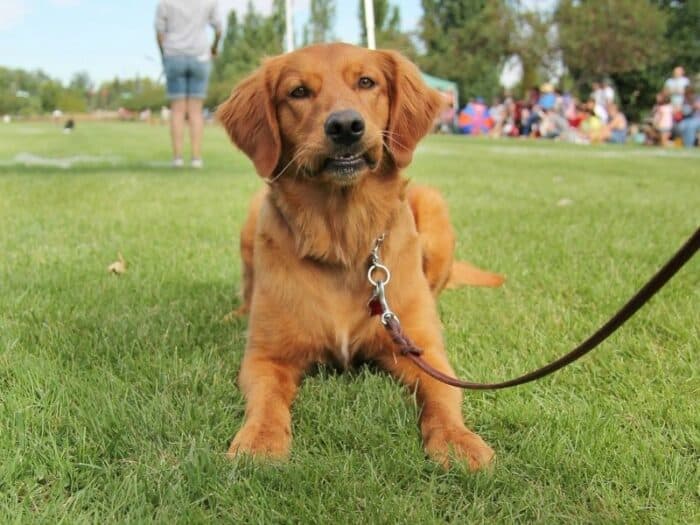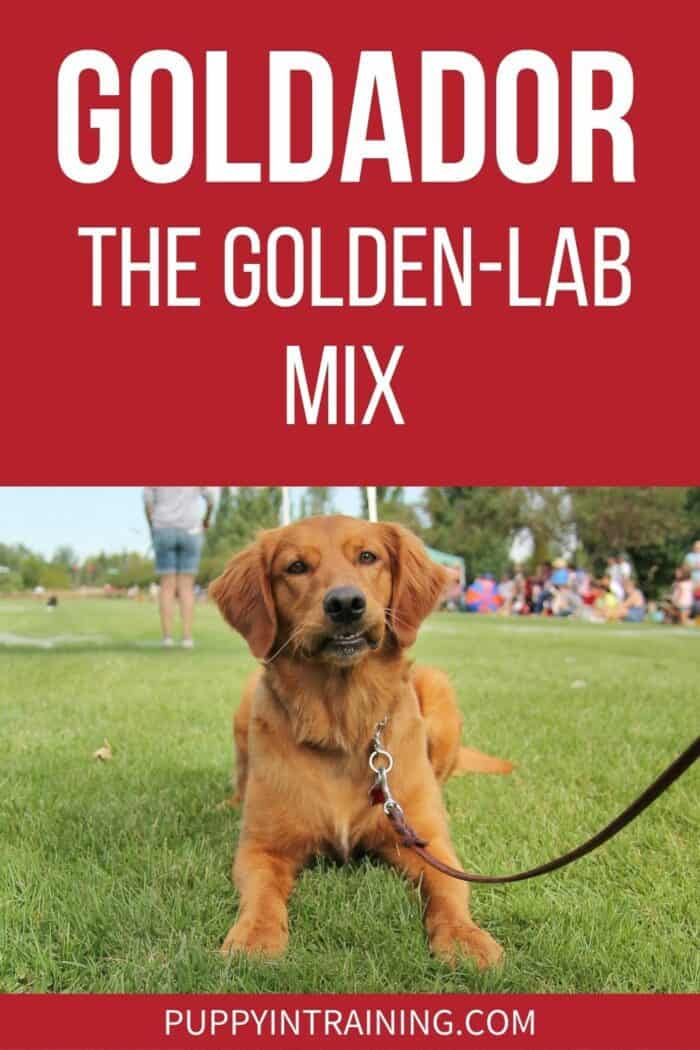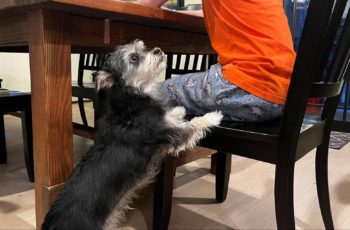This post may contain affiliate links. We may earn money or products from the companies mentioned in this post.
The Labrador retriever and the golden retriever are two of the most popular dog breeds in the United States.
Both are attractive and energetic dogs that are highly intelligent, easy to please, and incredibly friendly. It was only ever a matter of time before someone tried to cross these two breeds. The resulting crossbreed is known as the Goldador!
This crossbreed mixes the best of both parent breeds to create a friendly pup ideal for active families with children or for taking on sociable working roles.

With the right amount of love, affection, exercise, and mental stimulation, these crossbreeds make the perfect addition to any household.
Goldadors are even suitable for first-time owners, as long as their owner has enough time and energy to keep up with these energetic, loyal pups.
Read on to find out everything you need to know about Goldador dogs.
Goldador Main Characteristics
- Height: 22 to 24 inches
- Weight: 60 to 80 pounds
- Lifespan: 10 to 15 years
- Key Characteristics: Intelligent, highly trainable, friendly, good with children, high energy, moderate shedding
Goldador: History Of The Breed
Labrador Retrievers
Labrador retrievers were originally Canadian fishing dogs that were later imported to the UK and developed to be a retriever-gun dog. Since then, two distinct lines of the breed have evolved: the “English” and the “American” Labradors. There are also Australian Labradors, but they aren’t particularly common outside of Australia.
The Labrador is a sporty medium-sized dog with a stocky physique and a broad, square face. They usually weigh between 55 and 80 pounds. They tend to have a short, dense coat that is water-resistant, and these dogs love to swim! The most common coat colors are black, yellow, and chocolate.
Labradors are very friendly and tend to make friends with strangers and other animals with ease. They are highly intelligent and easy to please, which makes them easy to train. These characteristics combined make them excellent working dogs, especially when it comes to disability support. They are often used as guide dogs.
Labs are energetic dogs that need lots of exercise and attention. If they aren’t motivated by pleasing family members, they can become single-minded in other activities, which can be disruptive and destructive.
Golden Retrievers
Golden retrievers were also bred in the UK to retrieve shot waterfowl such as ducks. They have a soft mouth that allows them to delicately retrieve and bring back game undamaged. Like Labradors, golden retrievers also love water and are strong swimmers.
This is another medium-to-large breed that typically measures somewhere between 20 and 22 inches in height. They have a double coat with a top layer that is high shedding. As their name suggests, the golden retriever’s coat is usually golden or cream in color.
They are both friendly and confident, which makes them excellent family pets. They are also particularly good with children, who they will adopt as their own. While they will be protective of their people, golden retrievers are very friendly and more likely to go in for a pat and a play rather than bark or attack a stranger.
They are intelligent, biddable, and have a strong eagerness to please, which makes them highly trainable. This is why golden retrievers are also often used as working dogs in activities such as search and rescue as well as disability assistance. They love to work and will work until they drop if you don’t give them a break.
Goldador
Goldadors have been around for about 20 years and are an attempt to bring together the best of the Labrador and golden retriever breeds.
Normally, crossbred dogs can be highly unpredictable, because there is no reliable way of predicting how the genes of the two parent dogs will mix.
However, with Labs and Goldens, while we may not be able to predict their exact appearance, the temperaments of the two dogs are consistent enough that the resulting mix always has the friendly, intelligent, and easy to please temperament that most people are looking for.
Goldador Appearance
Goldadors are medium-to-large-sized dogs that typically measure between 20 and 24 inches tall and weigh somewhere between 55 and 80 pounds. Females tend to be noticeably smaller than the males. You can expect them to reach their full size somewhere between 18 and 24 months of age.
Goldadors typically have a double coat that mixes a short, thick, straight topcoat and a soft, dense undercoat. This allows them to enjoy a swim even in the coldest water, but it also means they tend to shed quite a lot. They need to be brushed at least once a week to remove dead hair and more often during seasonal shedding periods.
Their coat is likely to range in color from a yellowish gold to a reddish gold, though on rare occasions, they may inherit the black or chocolate coat of their Labrador parent.
It is difficult to predict whether the square face of the Labrador or the more pointed face of the golden retriever will be prevalent in their puppies.
Goldador Personality Traits
Friendliness
One of the most common words used to describe Goldadors and their parent breeds is “friendly.” They are naturally good-natured dogs who tend to want to be friends with everyone and everything.
While they might jump up to protect children they consider to be part of their family, aggression among these dogs is almost unheard of and will almost always relate to some kind of traumatic experience. They are more curious about other creatures than worried about them.
Unfortunately, this does mean Goldadors don’t make great guard dogs, as they are more likely to wander over for a scratch behind the ears than raise the alarm at the presence of a stranger.
Intelligence
Goldadors are extremely intelligent, and both of their parents are ranked among the most intelligent breeds.
This means not only that they can learn new commands quickly, but that they are also independent thinkers. They can figure out what is wanted from them in new situations based on their past experiences.
Of course, when not probably utilized, this intelligence can become problematic. A Goldador left at home for hours on end is likely to turn their keen mind into finding a way to escape.
Trainability
There are many intelligent dogs out there that are difficult to train primarily because they are incredibly stubborn. They know what you want; they just don’t want to comply.
Thankfully, Goldadors are eager to please and highly motivated by reward, which makes them extremely loyal and easy to train.
These dogs also have a great work ethic, and they enjoy having something to do. This means they make great working dogs, and they have the attention span to take on challenges such as disability support.
Even if you don’t want a working dog, it is a good idea to train your Goldador to do lots of different tasks. They find this mentally stimulating and emotionally rewarding.
Energy Level
Goldadors have lots of energy that needs to be burned off on a daily basis. They need a minimum of at least 30 minutes of solid exercise a day, but they will really thrive if given at least an hour or more of exercise per day.
Goldadors don’t like being cooped up and do best when they have space to roam around and do their own things during the day. They are better adapted to spaces with at least a small garden to apartment living.
They will particularly love joining their families on hikes and other adventures. They also love to swim, so swimming should make up a regular part of their activity.
Independence
Goldadors love being around their people. Even if they aren’t receiving attention, they like to know where their people are and what they are doing.
These are not the types of dogs you can leave at home for extended periods of time. While they might be able to settle down and do nothing for a few hours when you are around, if they are left alone, they can become anxious.
This prolonged anxiety can result in lots of nervous, and often destructive, energy.
Goldadors won’t cope particularly well if they are left to their own devices for 10 or more hours at a time while everyone is at work or school. While puzzle toys can help on occasion, they shouldn’t be left alone like this on a regular basis.
Goldador Health Risks
If you adopt a Goldador, you can expect them to live for roughly 10 to 15 years, which is a respectable amount of time for a large-sized dog.
They can be prone to inherited health conditions, but whether or not your Goldador will suffer from any of these ailments as they grow is pretty much the luck of the draw.
You can get some indication of their likelihood of developing these conditions if you look at the medical records of their parents.
One of the most common health problems affecting Goldadors is hip and elbow dysplasia. This is a malformation of the bones that occurs as they grow, as their bones grow at different rates and end up being the wrong size for one another.
The best way to prevent this is with a healthy diet and lots of exercise when they are young to prevent the problem from developing.
Check out our advice on choosing the right dog food for your Goldador.
These dogs can also develop joint issues in later life, which can make moving painful. If this happens, an orthopedic bed that helps take excess pressure off their joints can make a big difference.
Goldadors may also develop problems with their eyes, including cataracts and progressive retinal atrophy. These dogs often lose at least some of their sight as they pass through their senior years.
This breed of dog loves their food and they will often eat even when they aren’t hungry. If you don’t control your Goldador’s calorie intake for them, they can easily become overweight or even obese.
They also have a tendency to develop diabetes. If this happens, they will require a special diet.
Is a Golden-Lab Mix The Perfect Service Dog Breed?
I started raising guide and service dog puppies over 15 years ago. During that time I’ve seen the popularity of certain breeds come and go.
The Goldador has been gaining in popularity among many of the service dog schools.
When I spoke to the puppy program manager at Canine Companions for Independence, he told me that the majority of their service dogs were Labrador Retriever Golden Retriever mixes.
Many other schools have introduced Golden-Lab mixes into their service dog programs.
The mixed traits of both a Golden and a Lab is very popular among guide and service dog schools.
Should I Get A Goldador?
Having read all of this, you might still be wondering whether a Goldador is the right dog for you.
You should start by asking yourself whether you are in a position to make the commitment to adopting any dog. Remember, by adopting a dog, you are committing to care for, love, and support your pup for the next 10 to 15 years.
Keep these things in mind when adopting a dog, regardless of the breed:
- You should expect to spend at least $1,500 on your pup in the first year, including food, equipment, and veterinary bills.
- You should budget at least $1,000 a year to care for your dog following that.
- Do you have plans to move in the coming years? If so, will you be able to take your dog with you?
- Do you have someone who can look after your dog when you travel? This could be a friend, a family member, or a reputable kennel that is able to care for your dog for a certain period of time.
Once you have answered those questions, it is time to think about adopting a Goldador specifically. Be sure to ask yourself the following questions moving forward.
Do You Have Space?
Goldadors thrive when they have at least some outdoor space to call their own. They will struggle with apartment living. Be sure your outdoor space is properly fenced to prevent your Goldador from escaping if they get bored and start digging.
Do You Have Enough Time For A Goldador?
Goldadors need to be around people often. They can develop anxiety issues if left alone for extended periods of time. Are there people around the house most of the time to keep your dog company?
Also, will you be able to commit at least 30 to 60 minutes each day to providing your Goldador with exercise?
Be sure you have plenty of time to spend with your Goldador, as they can be fairly emotionally needy dogs.
Do You Have Enough Energy To Keep Up With A Goldador?
Goldadors not only need quite a bit of physical exercise, at least 30 minutes a day, but also quite a bit of mental stimulation. Their intelligence and work ethic mean they need someone to take the time to train them and keep them occupied.
If you don’t have enough energy to play with and entertain your Goldador, they can become bored and destructive.
Are You A First-Time Dog Owner?
Thankfully, Goldadors are actually excellent dogs for first-time owners. They are highly trainable, so even a novice should be able to teach them the essentials.
Their friendly nature means you are also very unlikely to end up with an aggressive dog that you struggle to control.
Do You Have Dog Hair Allergies Or Asthma?
Goldadors tend to shed a lot, so they aren’t good dogs if anyone in the home has an allergy. Additionally, if anyone in the home has asthma, you will want to groom your Goldador regularly to avoid leaving excess hair around the home.
Goldador FAQs
Are Goldadors good dogs?
Yes, Goldadors are excellent dogs that mix friendliness, intelligence, and energy in one adorable package. The characteristics of their parents tend to complement each other nicely to create a medium-to-large-sized dog that makes a great family pet or working pup.
How much does a Goldador cost?
The exact cost of a Goldador depends primarily on your location and whether you adopt from a shelter, a breeder, or elsewhere. Generally, you can expect your Goldador pup to cost around $800.
How do you train a Goldador puppy?
The best way to train most dogs is by using positive reinforcement. This means showing your pup the behavior that you would like and then rewarding them when they complete the behavior.
Positive reinforcement training teaches dogs how to perform desired behaviors and that they can expect good things to happen if they do it. Soon, it will become instinctive, and you will no longer need to reward them every time.
This is a particularly good form of training for Goldadors because they are highly motivated by both treats and pleasing.
It is never a good idea to punish dogs when they misbehave. To be useful, punishment needs to be delivered when they are “caught in the act.”
Punishing a dog when you get home because you discover that they have peed in the house will just lead to confusion, as they will not be able to associate the previous act with the current punishment.
Finally, punishment often teaches dogs different lessons than the ones you actually want them to learn. For example, instead of learning not to pee in the house, they might just learn not to pee while you are around.
The Verdict
When you cross-breed two of America’s most popular dogs, the Labrador retriever and the golden retriever, you get the Goldador: a friendly, intelligent, and agreeable dog that makes an excellent addition to any family.
They are great with children and have a temperament that first-time owners should be able to manage well.
They are energetic dogs that do best when they have some outdoor space to call their own and at least 30 minutes of exercise each day.
They also crave human companionship and are happiest when there are humans around most of the time, even if they aren’t spending time together.
Overall, Goldadors are:
- Highly intelligent and trainable
- Extremely loyal, but will develop separation anxiety if left alone for too long
- Large dogs that tend to shed heavily
Does this sound like the perfect canine companion for you? If so, then why not think about adopting a Goldador today?
If you are thinking about adopting from a shelter, consider reading our guide on what to expect when you bring your pup home.
Do you have any experience with Goldadors? Share your thoughts with the community in the comments section below.
Save To Pinterest

Top Picks For Our Puppies
- BEST PUPPY TOY
We Like: Snuggle Puppy w/ Heart Beat & Heat Pack – Perfect for new puppies. We get all of our Service Dog pups a Snuggle Puppy. - BEST DOG CHEW
We Like: Best Bully Sticks – All of our puppies love to bite, nip, and chew. We love using Bully Sticks to help divert these unwanted behaviors. - BEST DOG TREATS
We Like: Wellness Soft Puppy Bites – One of our favorite treats for training our service dog puppies. - BEST FRESH DOG FOOD
We Like: The Farmer’s Dog – A couple months ago we started feeding Raven fresh dog food and she loves it! Get 50% off your first order of The Farmer’s Dog.
Check out more of our favorites on our New Puppy Checklist.


